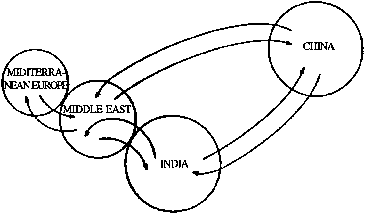
184
Figure 3. Elite migration linkages by ca. 1 A.D.
315
24) Two observations about these migration patterns seem worth making. First, mass migration was not
always a matter of a more or less free individual or group response to their perceptions of the world and
320 its opportunities. Obviously, the existence of civilization and cities, with the patterns of human migration
these communities created, put extraordinary strain upon the rural food-producing peasantry. Their efforts
sustained the city folk in a most direct fashion by raising the food the citizens consumed. They also
325 supported cities and rulers by exporting a portion of their offspring after having borne all the costs of
raising them from infancy to adolescence. It follows that high rural birth rates, as well as the regular
production of a lot more food than the village population of working age itself required, were preconditions
for the maintenance of civilized patterns of life.
330
25) If one reflects upon the hardships and difficulties such requirements placed upon the peasantry, it is
not surprising that population shortages in the countryside could and sometimes did threaten the survival
335 of city life and civilization. In such cases, legal enactment often sought to assure fulfillment of vital
functions by assigning individuals to specific jobs and roles in society. A second possibility was to recruit
labor by organizing slave raids aimed at bringing additional manpower to bear on tasks for which an
340 adequate supply of local personnel was not available. Slave soldiers and household servants were
sometimes more prominent in the past than slave cultivators; but since slaves seldom reproduced
themselves, all three kinds of slavery depended on the availability of a supply of enslaveable people
somewhere at a distance.
345 26) Wherever such pools of enslaveable population were discovered and exploited — whether in Africa or
on the Turkish steppes or in Russian villages — they constituted a sort of auxiliary reservoir of manpower
for civilized societies, supplementing the peasant manpower resources available closer at hand which had
350 proved insufficient to man all the posts and perform all the functions the civilized ruling classes wanted or
needed to have performed.
27) Secondly, it made a good deal of difference whether the circulatory patterns of migration I have
355 described were entered upon by isolated individuals and small family groups that left their native place and
moved to the city, into an army, or to the frontier as a result of individual decision, or whether such
channels of migration were instead entered upon by larger social groups—whole tribes or village — that
360 entered into the circulatory system of civilized society as organized communities, so that they could
maintain, e.g., a linguistic identity of their own in novel situations, and perpetuate distinctive cultural
characteristics even after they had entered into the very heart and core of civilized society. The Jews who
365 wept by the waters of Babylon in the time of Nebuchadnezzar and the Visigoths and Vandals who sacked
Rome in the fifth century A.D. sufficiently illustrate the difference that migration in organized groupings
can make to the historic role such migrants may play as against anything possible for isolated individuals
and small family groupings.
370
28) Finally, I should point out that the fourfold pattern of civilized migration in Eurasia that I have
sketched did not exclude other remarkable migratory movements during the historic age. Among peoples
375 but little affected by acquaintance with the skills of civilization, some quite extraordinary migratory
dispersals are known to have occurred. The Indonesian migration from Borneo to Madagascar, the
Polynesian migration through the islands of the central Pacific, the Eskimo circumpolar migration and the
380 Bantu migration within Africa each allowed human communities to penetrate and exploit in new ways

